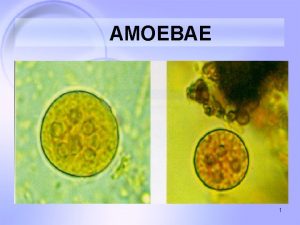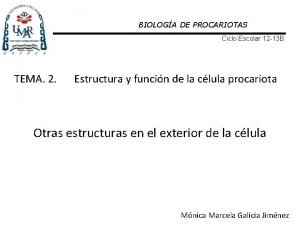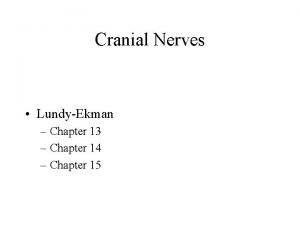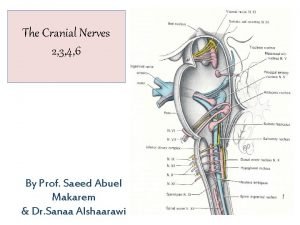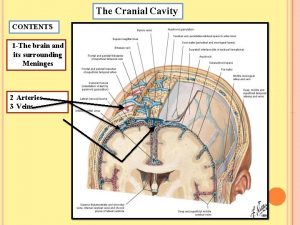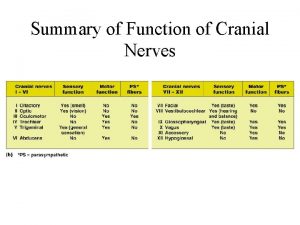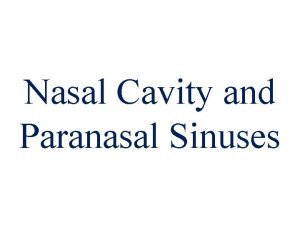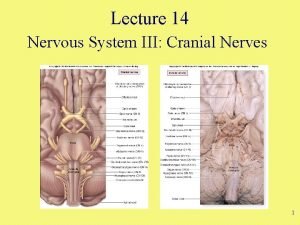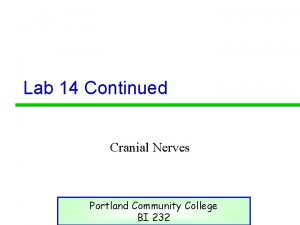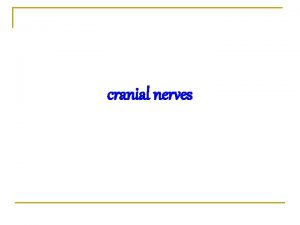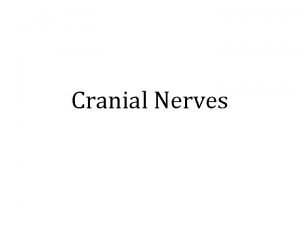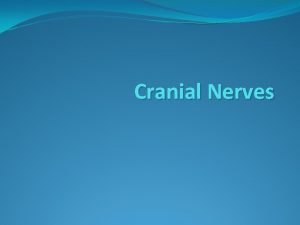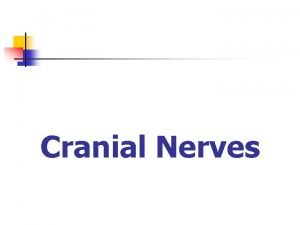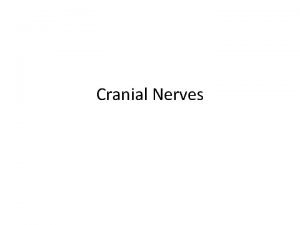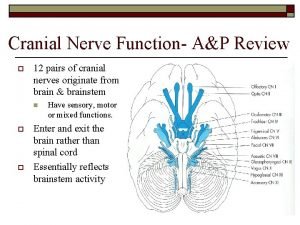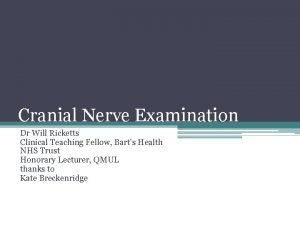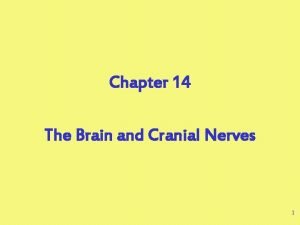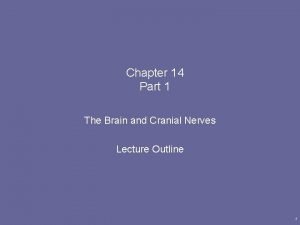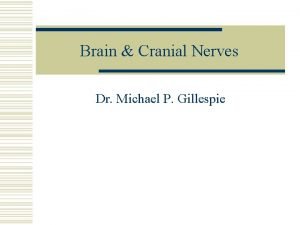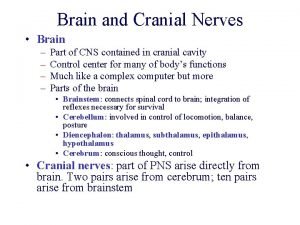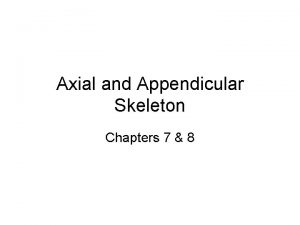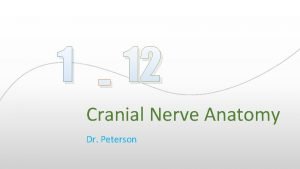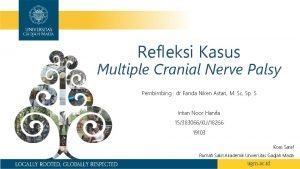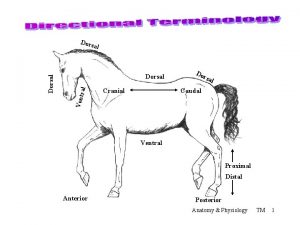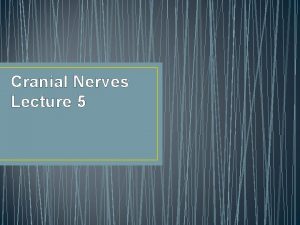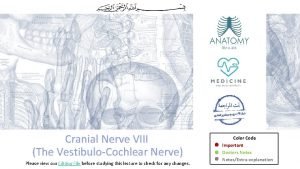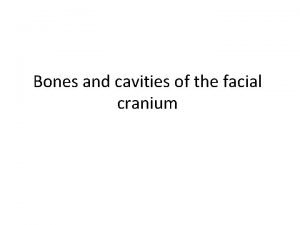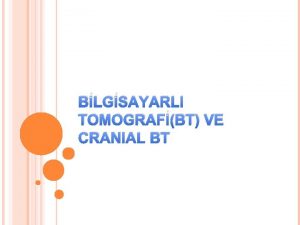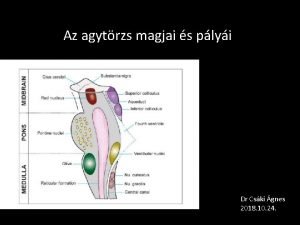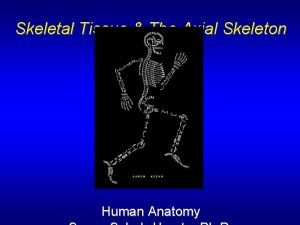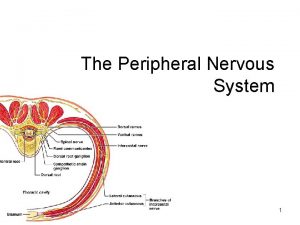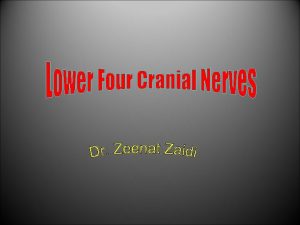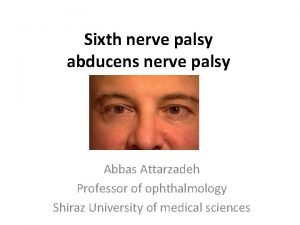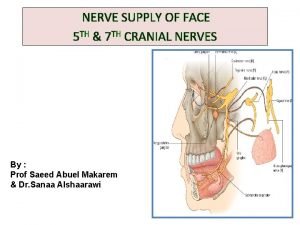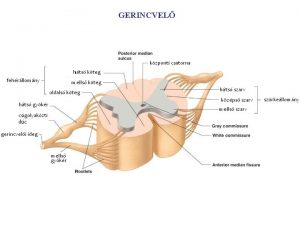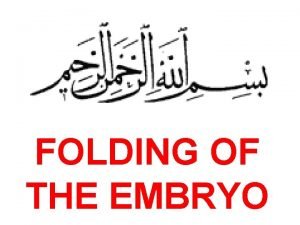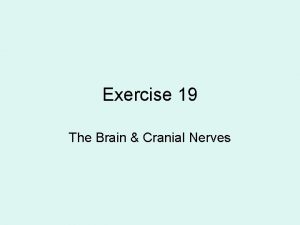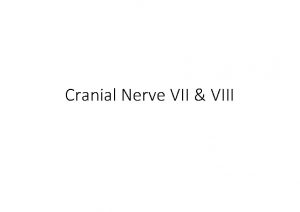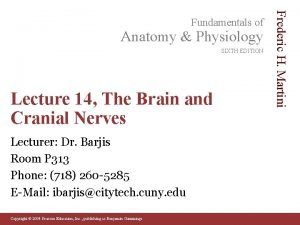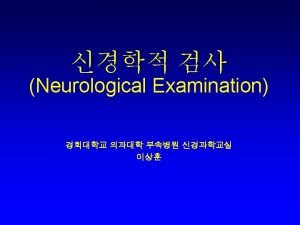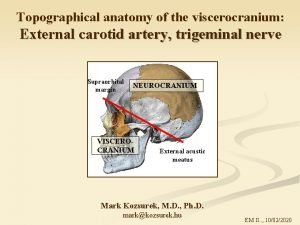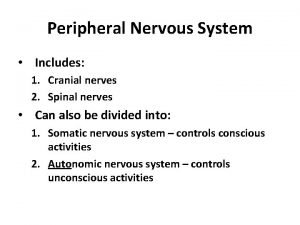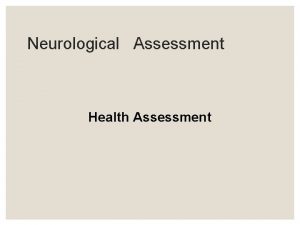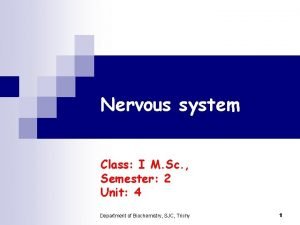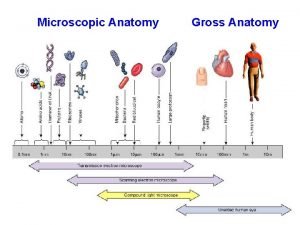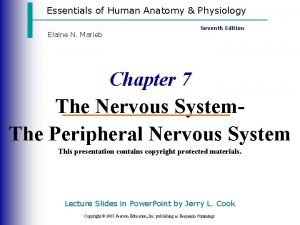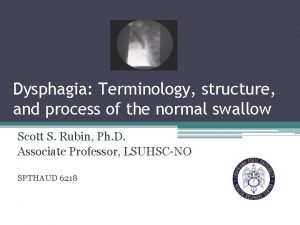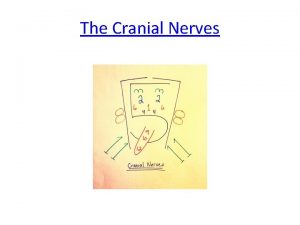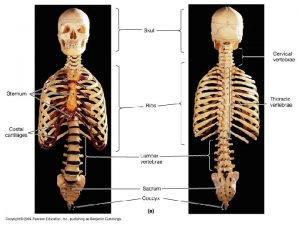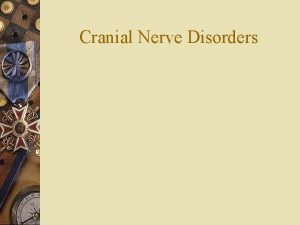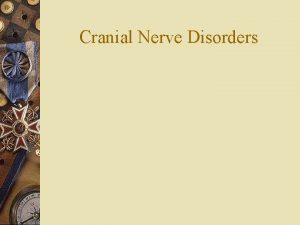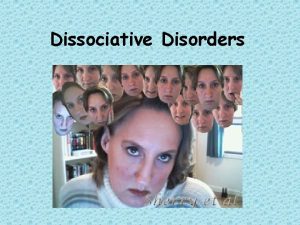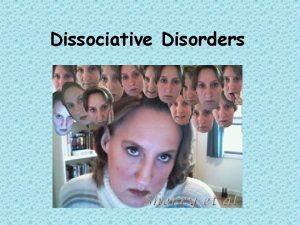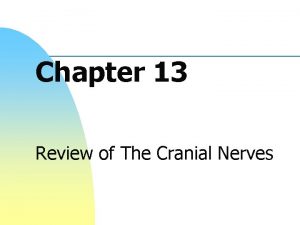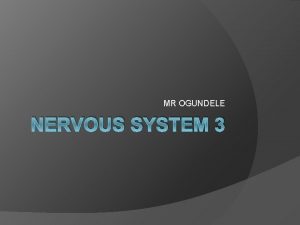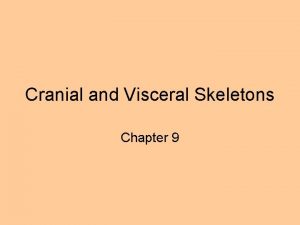1 Motility Disorders Overview CN CN Which cranial











































































- Slides: 75

1 Motility Disorders: Overview CN… CN… Which cranial nerves innervate the extraocular muscles (EOMs)?

2 Motility Disorders: Overview CN 3 CN 6 CN 4 Which cranial nerves innervate the extraocular muscles (EOMs)?

3 Motility Disorders: Overview CN 3 ? CN 6 ? CN 4 ? What is the name for the collections of neurons that give rise to each of these cranial nerves? (This is not a trick question--the answer is as obvious as it seems. )

4 Motility Disorders: Overview CN 3 Nucleus CN 6 Nucleus CN 4 Nucleus What is the name for the collections of neurons that give rise to each of these cranial nerves? (This is not a trick question--the answer is as obvious as it seems. )

5 Motility Disorders: Overview Um, Dr Flynn, 4 comes before 6. Why are these nuclei listed out of order? CN 3 Nucleus CN 6 Nucleus CN 4 Nucleus

6 Motility Disorders: Overview Um, Dr Flynn, 4 comes before 6. Why are these nuclei listed out of order? This will be explained shortly CN 3 Nucleus CN 6 Nucleus CN 4 Nucleus

7 Motility Disorders: Overview Nuclear CN 3 Nucleus (As we shall soon see, this ‘nuclear level’ serves as a useful point around which to organize the EOM-control pathway. ) CN 6 Nucleus CN 4 Nucleus

8 Motility Disorders: Overview ? ? Nuclear ? CN 3 Nucleus CN 6 Nucleus CN 4 Nucleus With respect to pathology of the EOM control pathways, there are four major ‘locations. ’ One of these (the nuclear) has been identified already. What are the other three? (Hint: Their names reflect the relationship each has to the nuclear level. )

9 Motility Disorders: Overview ? Note: While you’re familiar with these terms… ? Nuclear ? CN 3 Nucleus CN 6 Nucleus CN 4 Nucleus With respect to pathology of the EOM control pathways, there are four major ‘locations. ’ One of these (the nuclear) has been identified already. What are the other three? (Hint: Their names reflect the relationship each has to the nuclear level. )

10 Motility Disorders: Overview ? Note: While you’re familiar with these terms… ? Nuclear ? CN 3 Nucleus CN 6 Nucleus CN 4 Nucleus With respect to pathology of the EOM control pathways, there are four major ‘locations. ’ One of these (the nuclear) has been identified already. What are the other three? (Hint: Their names reflect the relationship each has to the nuclear level. ) …you may not be with this one, although you’ll agree it makes sense in context. (Further, and importantly, it is used in the BCSC Neuro book. )

11 Motility Disorders: Overview Supranuclear Note: While you’re familiar with these terms… Internuclear Nuclear Infranuclear CN 3 Nucleus CN 6 Nucleus CN 4 Nucleus With respect to pathology of the EOM control pathways, there are four major ‘locations. ’ One of these (the nuclear) has been identified already. What are the other three? (Hint: Their names reflect the relationship each has to the nuclear level. ) …you may not be with this one, although you’ll agree it makes sense in context. (Further, and importantly, it is used in the BCSC Neuro book. )

12 Supranuclear What sorts of inputs comprise the supranuclear pathways? Those from the cortex, cerebellum, vestibular system, and a number of brainstem and other nuclei An important rule-of-thumb can be stated regarding supranuclear motility disorders and diplopia--what is it? It is this: With four important exceptions, supranuclear pts do not complain of diplopia Nuclear Infranuclear CN 3 Nucleus CN 6 Nucleus CN 4 Nucleus

13 Supranuclear What sorts of inputs comprise the supranuclear pathways? Those from the cortex, cerebellum, vestibular system, and a number of brainstem nuclei An important rule-of-thumb can be stated regarding supranuclear motility disorders and diplopia--what is it? It is this: With four important exceptions, supranuclear pts do not complain of diplopia Nuclear Infranuclear CN 3 Nucleus CN 6 Nucleus CN 4 Nucleus

14 Supranuclear What sorts of inputs comprise the supranuclear pathways? Those from the cortex, cerebellum, vestibular system, and a number of brainstem nuclei An important rule-of-thumb can be stated regarding supranuclear motility disorders and diplopia--what is it? It is this: With four important exceptions, supranuclear pts do not complain of diplopia Nuclear Infranuclear CN 3 Nucleus CN 6 Nucleus CN 4 Nucleus

15 Supranuclear What sorts of inputs comprise the supranuclear pathways? Those from the cortex, cerebellum, vestibular system, and a number of brainstem nuclei An important rule-of-thumb can be stated regarding supranuclear motility disorders and diplopia--what is it? It is this: With four important exceptions, supranuclear pts do not complain of diplopia Nuclear Infranuclear CN 3 Nucleus CN 6 Nucleus CN 4 Nucleus

16 (Almost) all of these pts will not c/o diplopia Supranuclear Internuclear Nuclear Infranuclear CN 3 Nucleus CN 6 Nucleus (Almost) all of these pts will c/o diplopia CN 4 Nucleus Relationship between level of pathology and diplopia: The rule of thumb

17 Supranuclear What sorts of inputs comprise the supranuclear pathways? Motility Disorders: Overview (Almost) Those from the cortex, cerebellum, vestibular system, and a all of number of brainstem nuclei these pts Why don’t pts with supranuclear disorders have diplopia? will not Because supranuclear disorders affect both eyes in c/oa An important rule-of-thumb can be stated regarding symmetric fashion diplopia supranuclear motility disorders and diplopia--what is it? It is this: With four important. Internuclear exceptions, supranuclear pts do not complain of diplopia Nuclear Infranuclear CN 3 Nucleus CN 6 Nucleus (Almost) all of these pts will c/o diplopia CN 4 Nucleus Relationship between level of pathology and diplopia: The rule of thumb

18 Supranuclear What sorts of inputs comprise the supranuclear pathways? Motility Disorders: Overview (Almost) Those from the cortex, cerebellum, vestibular system, and a all of number of brainstem nuclei these pts Why don’t pts with supranuclear disorders have diplopia? will not Because supranuclear disorders affect both eyes in c/oa An important rule-of-thumb can be stated regarding symmetric fashion diplopia supranuclear motility disorders and diplopia--what is it? It is this: With four important. Internuclear exceptions, supranuclear pts do not complain of diplopia Nuclear Infranuclear CN 3 Nucleus CN 6 Nucleus (Almost) all of these pts will c/o diplopia CN 4 Nucleus Relationship between level of pathology and diplopia: The rule of thumb

19 Supranuclear What sorts of inputs comprise the supranuclear pathways? Motility Disorders: Overview (Almost) Those from the cortex, cerebellum, vestibular system, and a all of number of brainstem nuclei these pts Why don’t pts with supranuclear disorders have diplopia? will not Because supranuclear disorders affect both eyes in c/oa An important rule-of-thumb can be stated regarding symmetric fashion diplopia supranuclear motility disorders and diplopia--what is it? It is this: With four important exceptions, supranuclear pts Internuclear do not complain of diplopia What are the four supranuclear disorders Nuclear Infranuclear in which pts c/o diplopia? -CN 3 CN 6 -Nucleus --- (Almost) all of these pts will c/o diplopia CN 4 Nucleus Relationship between level of pathology and diplopia: The rule of thumb

20 Supranuclear What sorts of inputs comprise the supranuclear pathways? Motility Disorders: Overview (Almost) Those from the cortex, cerebellum, vestibular system, and a all of number of brainstem nuclei these pts Why don’t pts with supranuclear disorders have diplopia? will not Because supranuclear disorders affect both eyes in c/oa An important rule-of-thumb can be stated regarding symmetric fashion diplopia supranuclear motility disorders and diplopia--what is it? It is this: With four important exceptions, supranuclear pts Internuclear do not complain of diplopia What are the four supranuclear disorders Nuclear Infranuclear in which pts c/o diplopia? --Skew deviation CN 3 CN 6 --Divergence insufficiency Nucleus --Convergence insufficiency --Convergence spasm (Almost) all of these pts will c/o diplopia CN 4 Nucleus Relationship between level of pathology and diplopia: The rule of thumb

21 Supranuclear What sorts of inputs comprise the supranuclear pathways? Motility Disorders: Overview (Almost) Those from the cortex, cerebellum, vestibular system, and a What are some of the supranuclear disorders all of that present typically, number of brainstem nuclei ie, without diplopia? these pts Why--don’t pts with supranuclear disorders have diplopia? will not Because supranuclear disorders affect both eyes in -c/oa An important rule-of-thumb can be stated regarding symmetric fashion diplopia -supranuclear motility disorders and diplopia--what is it? -- It is this: With four important. Internuclear exceptions, supranuclear pts do not complain of diplopia What are the four supranuclear disorders Nuclear Infranuclear in which pts c/o diplopia? --Skew deviation CN 3 CN 6 --Divergence insufficiency Nucleus --Convergence insufficiency --Convergence spasm (Almost) all of these pts will c/o diplopia CN 4 Nucleus Relationship between level of pathology and diplopia: The rule of thumb

22 Supranuclear What sorts of inputs comprise the supranuclear pathways? Motility Disorders: Overview (Almost) Those from the cortex, cerebellum, vestibular system, and a What are some of the supranuclear disorders all of that present typically, number of brainstem nuclei ie, without diplopia? these pts Why--Gaze don’t pts with supranuclear palsies, eg, Parinauddisorders syndromehave diplopia? will not Because supranuclear disorders affect(COMA) both eyes in --Congenital ocular motor apraxia c/oa An important rule-of-thumb can be stated regarding symmetric fashion diplopia --Progressive palsy (PSP) supranuclear motility supranuclear disorders and diplopia--what is it? --Saccadic disorders It is this: With four important. Internuclear exceptions, supranuclear pts do not complain of diplopia What are the four supranuclear disorders Nuclear Infranuclear in which pts c/o diplopia? --Skew deviation CN 3 CN 6 --Divergence insufficiency Nucleus --Convergence insufficiency --Convergence spasm (Almost) all of these pts will c/o diplopia CN 4 Nucleus Relationship between level of pathology and diplopia: The rule of thumb

23 Supranuclear What sorts of inputs comprise the supranuclear pathways? Motility Disorders: Overview (Almost) Those from the cortex, cerebellum, vestibular system, and a What are some of the supranuclear disorders all of that present typically, number of brainstem nuclei ie, without diplopia? these pts Why--Gaze don’t pts with supranuclear have diplopia? palsies, eg, Parinauddisorders syndrome will not Because supranuclear disorders affect both eyes in --Congenital ocular motor apraxia (COMA) c/oa An important rule-of-thumb can be stated regarding symmetric fashionsupranuclear palsy (PSP) diplopia --Progressive supranuclear motility disorders and diplopia--what is it? --Saccadic disorders It is this: With four important. Internuclear exceptions, supranuclear pts do not complain of diplopia What are the four supranuclear disorders Nuclear in which pts c/o diplopia? --Skew deviation CN 3 CN 6 --Divergence insufficiency Nucleus --Convergence insufficiency --Convergence spasm Each of these is addressed in detail in other slide-sets--check the To. C Infranuclear (Almost) all of these pts will c/o diplopia CN 4 Nucleus Relationship between level of pathology and diplopia: The rule of thumb

24 Motility Disorders: Overview Supranuclear Internuclear Nuclear CN 3 Nucleus Are lesions of the CN 3 nucleus commonly encountered in clinical practice? Infranuclear CN 6 Nucleus CN 4 Nucleus

25 Motility Disorders: Overview Supranuclear Internuclear Nuclear CN 3 Nucleus Are lesions of the CN 3 nucleus commonly encountered in clinical practice? No, they are rare Infranuclear CN 6 Nucleus CN 4 Nucleus

26 Motility Disorders: Overview Supranuclear Internuclear Nuclear CN 3 Nucleus CN 6 Nucleus CN 4 Nucleus Are lesions of the CN 4 nucleus commonly encountered in clinical practice? Infranuclear

27 Motility Disorders: Overview Supranuclear Internuclear Nuclear CN 3 Nucleus CN 6 Nucleus CN 4 Nucleus Are lesions of the CN 4 nucleus commonly encountered in clinical practice? No, these are even rarer Infranuclear

28 Motility Disorders: Overview Supranuclear Internuclear Nuclear CN 3 Nucleus CN 6 Nucleus Are lesions of the CN 6 nucleus commonly encountered in clinical practice? Infranuclear CN 4 Nucleus

29 Motility Disorders: Overview Supranuclear Internuclear Nuclear CN 3 Nucleus CN 6 Nucleus Are lesions of the CN 6 nucleus commonly encountered in clinical practice? While not common, they are a well-known clinical entity Infranuclear CN 4 Nucleus

30 Motility Disorders: Overview Supranuclear Internuclear ? CN 4 Nucleus ^ CN 6 Nucleus ^ ? ^ CN 3 Nucleus ^ Nuclear Which two nuclei share an internuclear connection that is of wellestablished clinical importance? Infranuclear

31 Motility Disorders: Overview Supranuclear Internuclear Infranuclear CN 6 Nucleus ^ CN 3 Nucleus ^ Nuclear CN 4 Nucleus Which two nuclei share an internuclear connection that is of wellestablished clinical importance? 3 and 6 (Apropos a previous question: This is why the nuclei are not in numeric order!)

32 Motility Disorders: Overview Supranuclear Internuclear ? CN 6 Nucleus ^ CN 3 Nucleus ^ Nuclear What is the name of the internuclear pathway connecting the CN 3 and CN 6 nuclei? The medial longitudinal fasciculus (MLF) Infranuclear In which direction do impulses travel along the MLF? From the CN 6 to the CN 3 nucleus What condition is caused by disruption of the MLF? Internuclear ophthalmoplegia (INO) CN 4 Nucleus

33 Motility Disorders: Overview Supranuclear Internuclear MLF CN 6 Nucleus ^ CN 3 Nucleus ^ Nuclear What is the name of the internuclear pathway connecting the CN 3 and CN 6 nuclei? The medial longitudinal fasciculus (MLF) Infranuclear In which direction do impulses travel along the MLF? From the CN 6 to the CN 3 nucleus What condition is caused by disruption of the MLF? Internuclear ophthalmoplegia (INO) CN 4 Nucleus

34 Motility Disorders: Overview Supranuclear Internuclear MLF CN 6 Nucleus ^ CN 3 Nucleus ^ Nuclear What is the name of the internuclear pathway connecting the CN 3 and CN 6 nuclei? The medial longitudinal fasciculus (MLF) Infranuclear In which direction do impulses travel along the MLF? From the CN 6 to the CN 3 nucleus What condition is caused by disruption of the MLF? Internuclear ophthalmoplegia (INO) CN 4 Nucleus

35 Motility Disorders: Overview Supranuclear CN 3 Nucleus MLF CN 6 Nucleus ^ Nuclear ^ Internuclear What is the name of the internuclear pathway connecting the CN 3 and CN 6 nuclei? The medial longitudinal fasciculus (MLF) Infranuclear In which direction do impulses travel along the MLF? From the CN 6 to the CN 3 nucleus What condition is caused by disruption of the MLF? Internuclear ophthalmoplegia (INO) CN 4 Nucleus

36 Motility Disorders: Overview Supranuclear CN 3 Nucleus MLF CN 6 Nucleus ^ Nuclear ^ Internuclear What is the name of the internuclear pathway connecting the CN 3 and CN 6 nuclei? The medial longitudinal fasciculus (MLF) Infranuclear In which direction do impulses travel along the MLF? From the CN 6 to the CN 3 nucleus What condition is caused by disruption of the MLF? Internuclear ophthalmoplegia (INO) CN 4 Nucleus

37 Motility Disorders: Overview Supranuclear CN 3 Nucleus MLF CN 6 Nucleus ^ Nuclear ^ Internuclear What is the name of the internuclear pathway connecting the CN 3 and CN 6 nuclei? The medial longitudinal fasciculus (MLF) Infranuclear In which direction do impulses travel along the MLF? From the CN 6 to the CN 3 nucleus What condition is caused by disruption of the MLF? Internuclear ophthalmoplegia (INO) CN 4 Nucleus

38 Motility Disorders: Overview Supranuclear CN 3 Nucleus MLF CN 6 Nucleus ^ Nuclear ^ Internuclear What is the name of the internuclear pathway connecting the CN 3 and CN 6 nuclei? The medial longitudinal fasciculus (MLF) Infranuclear In which direction do impulses travel along the MLF? From the CN 6 to the CN 3 nucleus What condition is caused by disruption of the MLF? Internuclear ophthalmoplegia (INO) INO is addressed in detail in its own slide-set (N 20) CN 4 Nucleus

39 Motility Disorders: Overview Supranuclear Infranuclear CN 3 Nucleus MLF CN 6 Nucleus ^ Nuclear ^ Internuclear CN 4 Nucleus Next we will turn our attention to the infranuclear pathway, which proceeds in an ordered fashion from the nuclei to the extraocular muscles themselves

40 Motility Disorders: Overview Supranuclear ? ? Infranuclear ? ? MLF CN 6 Nucleus ^ CN 3 Nucleus Nuclear ^ Internuclear CN 4 Nucleus The first portion of the nerve as it leaves the nucleus, but before leaving the substance of the brainstem

41 Motility Disorders: Overview Supranuclear Fascicular ? Infranuclear ? ? MLF CN 6 Nucleus ^ CN 3 Nucleus Nuclear ^ Internuclear CN 4 Nucleus The first portion of the nerve as it leaves the nucleus, but before leaving the substance of the brainstem

42 Motility Disorders: Overview Supranuclear CN 3 Nucleus MLF CN 6 Nucleus ^ Nuclear ^ Internuclear CN 4 Nucleus Fascicular The cranial-nerve ? nuclei and their fascicles are located within the brainstem. Given this, it shouldn’t come as a surprise that, generally speaking, lesions of ? the nuclei and/or fascicles do not present with isolated EOM abnormalities; ie, Infranuclear the ophthalmoparesis is almost always accompanied by nonocular signs and symptoms of CNS? damage. ? What general term is used to describe conditions presenting with motility dysfunction 2 ndry to fascicle damage + non-ocular CNS findings? ? Fascicular syndrome

43 Motility Disorders: Overview Supranuclear CN 3 Nucleus MLF CN 6 Nucleus ^ Nuclear ^ Internuclear CN 4 Nucleus Fascicular The cranial-nerve ? nuclei and their fascicles are located within the brainstem. Given this, it shouldn’t come as a surprise that, generally speaking, lesions of ? the nuclei and/or fascicles do not present with isolated EOM abnormalities; ie, Infranuclear the ophthalmoparesis is almost always accompanied by nonocular signs and symptoms of CNS? damage. ? What general term is used to describe conditions presenting with motility dysfunction 2 ndry to fascicle damage + non-ocular CNS findings? ? Fascicular syndrome

44 Motility Disorders: Overview Supranuclear CN 3 Nucleus MLF CN 6 Nucleus ^ Nuclear ^ Internuclear CN 4 Nucleus Fascicular The cranial-nerve ? nuclei and their fascicles are located within the brainstem. Given this, it shouldn’t come as a surprise that, generally speaking, lesions of ? the nuclei and/or fascicles do not present with isolated EOM abnormalities; ie, Infranuclear the ophthalmoparesis is almost always accompanied by nonocular signs and symptoms of CNS? damage. ? What general term is used to describe conditions presenting with motility dysfunction 2 ndry to fascicle damage + non-ocular CNS findings? ? Fascicular syndrome

45 Motility Disorders: Overview Supranuclear MLF CN 6 Nucleus ^ CN 3 Nucleus Nuclear ^ Internuclear CN 4 Nucleus Fascicular ? Infranuclear ? ? Speaking of fascicular syndromes…the Neuro book describes four involving the CN 3 fascicle, and two for the CN 6. Name them. CN 3 fascicular syndromes: ----CN 6 fascicular syndromes: --Foville syndrome --Millard-Gubler syndrome

46 Motility Disorders: Overview Supranuclear MLF CN 6 Nucleus ^ CN 3 Nucleus Nuclear ^ Internuclear CN 4 Nucleus Fascicular ? Infranuclear ? ? Speaking of fascicular syndromes…the Neuro book describes four involving the CN 3 fascicle, and two for the CN 6. Name them. CN 3 fascicular syndromes: --Weber syndrome --Benedikt syndrome --Claude syndrome --Nothnagel syndrome CN 6 fascicular syndromes: --Foville syndrome --Millard-Gubler syndrome

47 Motility Disorders: Overview Supranuclear MLF CN 6 Nucleus ^ CN 3 Nucleus Nuclear ^ Internuclear CN 4 Nucleus Fascicular ? Infranuclear ? ? Speaking of fascicular syndromes…the Neuro book describes four involving the CN 3 fascicle, and two for the CN 6. Name them. CN 3 fascicular syndromes: --Weber syndrome --Benedikt syndrome --Claude syndrome --Nothnagel syndrome CN 6 fascicular syndromes: ---

48 Motility Disorders: Overview Supranuclear MLF CN 6 Nucleus ^ CN 3 Nucleus Nuclear ^ Internuclear CN 4 Nucleus Fascicular ? Infranuclear ? ? Speaking of fascicular syndromes…the Neuro book describes four involving the CN 3 fascicle, and two for the CN 6. Name them. CN 3 fascicular syndromes: --Weber syndrome --Benedikt syndrome --Claude syndrome --Nothnagel syndrome CN 6 fascicular syndromes: --Foville syndrome --Millard-Gubler syndrome

49 Motility Disorders: Overview Supranuclear MLF CN 6 Nucleus ^ CN 3 Nucleus Nuclear ^ Internuclear CN 4 Nucleus Fascicular ? Infranuclear ? ? Speaking of fascicular syndromes…the Neuro book describes four involving the CN 3 fascicle, and two for the CN 6. Name them. CN 3 fascicular syndromes: --Weber syndrome The fascicular syndromes --Benedikt syndrome --Claude syndrome are addressed in detail in --Nothnagel syndrome their own slide-set (N 14) CN 6 fascicular syndromes: --Foville syndrome --Millard-Gubler syndrome

50 Motility Disorders: Overview Supranuclear MLF CN 6 Nucleus ^ CN 3 Nucleus Nuclear ^ Internuclear CN 4 Nucleus Fascicular ? Infranuclear ? ? The next portion commences once the fascicles exit the brainstem--now they’re a nerve. Named for the space in which the nerves travel.

51 Motility Disorders: Overview Supranuclear MLF CN 6 Nucleus ^ CN 3 Nucleus Nuclear ^ Internuclear CN 4 Nucleus Fascicular Subarachnoid Infranuclear ? ? The next portion commences once the fascicles exit the brainstem--now they’re a nerve. Named for the space in which the nerves travel.

52 Motility Disorders: Overview Supranuclear MLF Fascicular Subarachnoid Infranuclear ? ? CN 6 Nucleus ^ CN 3 Nucleus Nuclear ^ Internuclear CN 4 Nucleus Which cause of ophthalmoparesis--common among vasculopaths--is attributed to damage occurring to the subarachnoid segments? Ischemic palsies (ie, a so-called ‘diabetic’ 3 rd or 6 th nerve palsy)

53 Motility Disorders: Overview Supranuclear MLF Fascicular Subarachnoid Infranuclear ? ? CN 6 Nucleus ^ CN 3 Nucleus Nuclear ^ Internuclear CN 4 Nucleus Which cause of ophthalmoparesis--common among vasculopaths--is attributed to damage occurring to the subarachnoid segments? Ischemic palsies (ie, a so-called ‘diabetic third’ or ‘diabetic sixth’)

54 Motility Disorders: Overview Supranuclear MLF CN 6 Nucleus ^ CN 3 Nucleus Nuclear ^ Internuclear CN 4 Nucleus Fascicular Subarachnoid Infranuclear ? ? The nerves then leave the subarachnoid space by diving into a space of a very different sort. This portion is named for the space entered into.

55 Motility Disorders: Overview Supranuclear CN 3 Nucleus MLF CN 6 Nucleus ^ Nuclear ^ Internuclear CN 4 Nucleus Fascicular Subarachnoid Infranuclear Cavernous sinus ? ? ? The nerves then leave the subarachnoid space by diving into a space of a very different sort. This portion is named for the space entered into.

56 Motility Disorders: Overview Supranuclear CN 3 Nucleus MLF Fascicular Subarachnoid Infranuclear Cavernous sinus ? ? ? CN 6 Nucleus ^ Nuclear ^ Internuclear CN 4 Nucleus What is the hallmark of ophthalmoplegia 2 ndry to a cavernous sinus process? The involvement of two or more cranial nerves simultaneously Which nerves may be involved? --CN 3 --CN 4 --CN 6 --V 1 --V 2 --Sympathetics

57 Motility Disorders: Overview Supranuclear CN 3 Nucleus MLF Fascicular Subarachnoid Infranuclear Cavernous sinus ? ? ? CN 6 Nucleus ^ Nuclear ^ Internuclear CN 4 Nucleus What is the hallmark of ophthalmoplegia 2 ndry to a cavernous sinus process? The involvement of two or more cranial nerves simultaneously Which nerves may be involved? --CN 3 --CN 4 --CN 6 --V 1 --V 2 --Sympathetics

58 Motility Disorders: Overview Supranuclear CN 3 Nucleus MLF Fascicular Subarachnoid Infranuclear Cavernous sinus ? ? ? CN 6 Nucleus ^ Nuclear ^ Internuclear CN 4 Nucleus What is the hallmark of ophthalmoplegia 2 ndry to a cavernous sinus process? The involvement of two or more cranial nerves simultaneously Which nerves may be involved? -------

59 Motility Disorders: Overview Supranuclear CN 3 Nucleus MLF Fascicular Subarachnoid Infranuclear Cavernous sinus ? ? ? CN 6 Nucleus ^ Nuclear ^ Internuclear CN 4 Nucleus What is the hallmark of ophthalmoplegia 2 ndry to a cavernous sinus process? The involvement of two or more cranial nerves simultaneously Which nerves may be involved? -Involvement manifests as ophthalmoplegia ---Involvement manifests as facial hypoesthesia --Involvement manifests as Horners

60 Motility Disorders: Overview Supranuclear CN 3 Nucleus MLF Fascicular Subarachnoid Infranuclear Cavernous sinus ? ? ? CN 6 Nucleus ^ Nuclear ^ Internuclear CN 4 Nucleus What is the hallmark of ophthalmoplegia 2 ndry to a cavernous sinus process? The involvement of two or more cranial nerves simultaneously Which nerves may be involved? -Involvement manifests as ophthalmoplegia ---Involvement manifests as facial hypoesthesia --Involvement manifests as Horners

61 Motility Disorders: Overview Supranuclear CN 3 Nucleus MLF Fascicular Subarachnoid Infranuclear Cavernous sinus ? ? ? CN 6 Nucleus ^ Nuclear ^ Internuclear CN 4 Nucleus What is the hallmark of ophthalmoplegia 2 ndry to a cavernous sinus process? The involvement of two or more cranial nerves simultaneously Which nerves may be involved? --CN 3 Involvement manifests as ophthalmoplegia --CN 4 --CN 6 --V 1 Involvement manifests as facial hypoesthesia --V 2 --Sympathetics Involvement manifests as Horners

62 Motility Disorders: Overview Supranuclear CN 3 Nucleus MLF CN 6 Nucleus ^ Nuclear ^ Internuclear CN 4 Nucleus Fascicular Subarachnoid Infranuclear Cavernous sinus ? ? ? Getting pretty close now. Post-cavernous sinus, another well-defined space.

63 Motility Disorders: Overview Supranuclear CN 3 Nucleus MLF CN 6 Nucleus ^ Nuclear ^ Internuclear CN 4 Nucleus Fascicular Subarachnoid Infranuclear Cavernous sinus Orbital ? ? Getting pretty close now. Post-cavernous sinus, another well-defined space.

64 Motility Disorders: Overview Supranuclear CN 3 Nucleus MLF CN 6 Nucleus ^ Nuclear ^ Internuclear CN 4 Nucleus Fascicular Subarachnoid Infranuclear Cavernous sinus Superior orbital fissure Orbital ? ? BTW, the answer superior orbital fissure is just as good here as ‘orbit’ (if not better, as the Neuro book breaks out the fissure as a separate structure in the pathway)

65 Motility Disorders: Overview Supranuclear CN 3 Nucleus MLF CN 6 Nucleus ^ Nuclear ^ Internuclear CN 4 Nucleus Fascicular Subarachnoid Infranuclear Cavernous sinus Superior orbital fissure Orbital apex Orbital ? ? Likewise, the answer orbital apex would also be reasonable at this junction

66 Motility Disorders: Overview Supranuclear CN 3 Nucleus MLF CN 6 Nucleus ^ Nuclear ^ Internuclear CN 4 Nucleus Fascicular Subarachnoid Infranuclear Cavernous sinus Superior orbital fissure Orbital apex Orbital ? ? Motility disorders 2 ndry to pathology in these areas are addressed in detail in their own slide-set (N 19)

67 Motility Disorders: Overview Supranuclear CN 3 Nucleus MLF CN 6 Nucleus ^ Nuclear ^ Internuclear CN 4 Nucleus Fascicular Subarachnoid Infranuclear Cavernous sinus Orbital ? ? Where the journey ends for the nerves.

68 Motility Disorders: Overview Supranuclear CN 3 Nucleus MLF CN 6 Nucleus ^ Nuclear ^ Internuclear CN 4 Nucleus Fascicular Subarachnoid Infranuclear Cavernous sinus Orbital Neuromuscular junction ? Where the journey ends for the nerves.

69 Motility Disorders: Overview Supranuclear CN 3 Nucleus MLF CN 6 Nucleus ^ Nuclear ^ Internuclear CN 4 Nucleus Fascicular Subarachnoid Infranuclear Cavernous sinus Orbital Neuromuscular junction ? Per the Neuro book, what is the “prototypical” disease of the neuromuscular junction? Myasthenia gravis

70 Motility Disorders: Overview Supranuclear CN 3 Nucleus MLF CN 6 Nucleus ^ Nuclear ^ Internuclear CN 4 Nucleus Fascicular Subarachnoid Infranuclear Cavernous sinus Orbital Neuromuscular junction ? Per the Neuro book, what is the “prototypical” disease of the neuromuscular junction? Myasthenia gravis

71 Motility Disorders: Overview Supranuclear CN 3 Nucleus MLF CN 6 Nucleus ^ Nuclear ^ Internuclear CN 4 Nucleus Fascicular Subarachnoid Infranuclear Cavernous sinus Orbital Neuromuscular junction ? And finally…Don’t forget pathology here when evaluating motility disorders!

72 Motility Disorders: Overview Supranuclear CN 3 Nucleus MLF CN 6 Nucleus ^ Nuclear ^ Internuclear CN 4 Nucleus Fascicular Subarachnoid Infranuclear Cavernous sinus Orbital Neuromuscular junction Extraocular muscle And finally…Don’t forget pathology here when evaluating motility disorders!

73 Motility Disorders: Overview Supranuclear CN 3 Nucleus MLF CN 6 Nucleus ^ Nuclear ^ Internuclear CN 4 Nucleus Fascicular Subarachnoid Infranuclear Cavernous sinus What. Orbital sorts of conditions are included here? Restrictive (eg, thyroid eye dz); inflammatory (eg, orbital myositis); myopathies (eg, chronic progressive Neuromuscular junctionexternal ophthalmoplegia) Extraocular muscle

74 Motility Disorders: Overview Supranuclear CN 3 Nucleus MLF CN 6 Nucleus ^ Nuclear ^ Internuclear CN 4 Nucleus Fascicular Subarachnoid Infranuclear Cavernous sinus What. Orbital sorts of conditions are included here? Restrictive (eg, thyroid eye dz); inflammatory (eg, orbital myositis); myopathies (eg, chronic progressive Neuromuscular junctionexternal ophthalmoplegia) Extraocular muscle

75 Motility Disorders: Overview Supranuclear CN 3 Nucleus MLF Fascicular Subarachnoid Infranuclear Cavernous sinus CN 6 Nucleus ^ Nuclear ^ Internuclear Commit this slide to memory, and use it to organize your thought process when dealing with an ophthalmoparesis pt! Orbital Neuromuscular junction Extraocular muscle CN 4 Nucleus
 Average motility of sperm
Average motility of sperm Motility vs mobility
Motility vs mobility Motility test positive and negative
Motility test positive and negative Hanging drop method diagram
Hanging drop method diagram Entamoeba histolytica motility
Entamoeba histolytica motility Stately motility
Stately motility Salmonella motility
Salmonella motility Reproduccion bacteriana
Reproduccion bacteriana üyou
üyou Ipsilateral cranial nerves
Ipsilateral cranial nerves Trigeminal nerve which cranial nerve
Trigeminal nerve which cranial nerve Oculomotor nerve
Oculomotor nerve Subdural hemorrhage
Subdural hemorrhage Classification of cranial nerves
Classification of cranial nerves Middle cranial fossa
Middle cranial fossa On occasion our trusty truck
On occasion our trusty truck Limen nasi
Limen nasi Old opie occasionally tries trigonometry
Old opie occasionally tries trigonometry Trigeminal nerve
Trigeminal nerve Cranial fermenters
Cranial fermenters Theories of craniofacial growth
Theories of craniofacial growth Afferent cranial nerves
Afferent cranial nerves Brain nerves labeled
Brain nerves labeled Cranial nerves
Cranial nerves Cranial accessory nerve supplies
Cranial accessory nerve supplies Cranial nerves special senses
Cranial nerves special senses Oculomotor nerve nucleus
Oculomotor nerve nucleus Olfactory nerve
Olfactory nerve Cranial nerves classification
Cranial nerves classification How to assess vestibulocochlear nerve
How to assess vestibulocochlear nerve Cn viii test
Cn viii test Brain falx
Brain falx Cranial nerves labeled with roman numerals
Cranial nerves labeled with roman numerals Figure 14-2 cranial nerves labeled
Figure 14-2 cranial nerves labeled Cranial nerve 4 function
Cranial nerve 4 function Cranial nerves labeled with roman numerals
Cranial nerves labeled with roman numerals Anterior cranial fossa
Anterior cranial fossa What are bone surface markings
What are bone surface markings Rounded bulge on underside of brainstem
Rounded bulge on underside of brainstem Cranial nerves 346
Cranial nerves 346 Multiple cranial nerve palsy
Multiple cranial nerve palsy First and second cranial nerves
First and second cranial nerves Agyidegek
Agyidegek Caudal and dorsal
Caudal and dorsal Neucience
Neucience First and second cranial nerves
First and second cranial nerves Cranial nerves foramina
Cranial nerves foramina Nükleos
Nükleos Tractus corticobulbaris
Tractus corticobulbaris Falx cerebri
Falx cerebri Mesenchyme cells
Mesenchyme cells Premotor area
Premotor area Cranial nerves labeled
Cranial nerves labeled Cranial nerves
Cranial nerves Nerve pulsy
Nerve pulsy How do you get meningitis
How do you get meningitis Bell's palsy
Bell's palsy Keresztezett hajlító feszítő reflex
Keresztezett hajlító feszítő reflex Cranial caudal folding
Cranial caudal folding Ventricles brain
Ventricles brain Vestibulocochlear nerve nuclei
Vestibulocochlear nerve nuclei Cephalic cranial
Cephalic cranial What does the suffix malacia mean
What does the suffix malacia mean Principles of anatomy and physiology tortora
Principles of anatomy and physiology tortora Dismetria
Dismetria Infraorbital artery
Infraorbital artery Cranial fossa
Cranial fossa Cranial nerve mnemonic
Cranial nerve mnemonic Pleomorphic adenoma
Pleomorphic adenoma Brachioradialis reflex
Brachioradialis reflex Electrical properties of nerve ppt
Electrical properties of nerve ppt Loin anatomy
Loin anatomy Cranial nerves sensory and motor
Cranial nerves sensory and motor Define clinical anatomy
Define clinical anatomy Cranial nerve mnemonics
Cranial nerve mnemonics Minor salivary glands
Minor salivary glands




